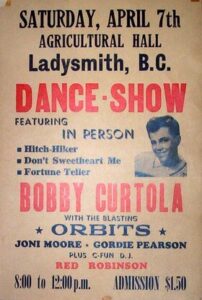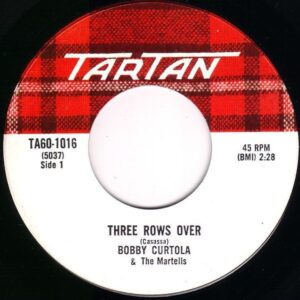#371: Three Rows Over by Bobby Curtola
Peak Month: September 1963
9 weeks on Vancouver’s CFUN chart
Peak Position #2
Peak Position on Billboard Hot 100 ~ did not chart
YouTube: “Three Rows Over”
Lyrics: “Three Rows Over”
Bobby Curtola was born in Port Arthur, Ontario, in 1943. (The town would become amalgamated into the city of Thunder Bay in 1970). His cousin Susan Andrusco remembers “”Bobby would always be singing at our family gatherings. The family loved him. And he loved being the centre of attention. He would sing Oh My Papa, and my grandpa would cry.” Oh My Papa was a number-one hit for Eddie Fisher in January 1954, when Bobby Curtola was still ten-years-old. In the fall of 1959, sixteen-year-old high school student Bobby Curtola went from pumping gas at his father’s garage in Thunder Bay, Ontario, to the life of a teen idol. Within a year he went from playing in his basement band, Bobby and the Bobcats, to recording his first hit single in 1960, “Hand In Hand With You”, which charted in June ’60 in Ontario, but not in Vancouver.
After performing on the Bob Hope Show in 1960, the charismatic teenager, with his handsome boy-next-door looks was quickly finding himself within a whirlwind called “Curtolamania.”
Bobby set out on his first Western Canadian Tour in the fall of 1960. From there Curtola went on to become a trailblazer. He toured the first coast to coast tour circuit in Canada. In 1961 he went to Nashville to record with Bill Porter for RCA Studios. That relationship continued for decades. “Don’t You Sweetheart Me” was his first Top Ten hit in Canada. The song climbed to #1 in Winnipeg, #4 in Vancouver and #5 in Toronto. In September 1961 Curtola was back on the CFUN chart in Vancouver with “I’ll Never Be Alone Again”. He had another hit on his hands four months later with “Hitchhiker“.
Between 1960 and 1968 Curtola had continual single and album releases on the Tartan label in Canada. The managers and main songwriters were brothers Dyer and Basil Hurdon. The Del-Fi label released some of those singles in the US. His biggest hit, “Fortune Teller”, was released in 1962 and went Gold in Canada. The now Rock n’ Roll Hall of Fame DJ, Red Robinson, was key in the success of “Fortune Teller.” Seeing its potential internationally, Robinson sent it to Disc Jockey’s in Seattle at KJR and Hawaii’s KPOI in Honolulu. A major US record deal was signed and “Fortune Teller” went on to sell two and a half million copies.
Curtola traveled to many towns in British Columbia, including the Vancouver Island town of Ladysmith on April 7, 1962, while “Fortune Teller” and “Johnny Take Your Time” were charting all over the province.

Bobby Curtola was invited in 1962 to tour with Dick Clark and his Cavalcade of Stars. Curtola also enjoyed other Top 20 hit in ’62 in Vancouver with “You Must Belong To Me” and “I Cry And Cry“. He had a #4 hit in October ’62 with “Aladdin”, which spent seven weeks in the Top Ten on the CFUN chart.
In early 1963 Bobby Curtola had his second number-one hit in Vancouver titled “Destination Love”. After the single began to chart on CFUN in mid-January ’63, Curtola was in Vancouver and had a live interview with Red Robinson. Curtola performed in concert in Vancouver in 1963 when he was at the height of his popularity. Red Robinson said in an interview after Curtola died “Bobby broke out in the early Sixties and when he appeared in Vancouver at Park Royal mall over 3,000 kids showed up. I met him when I was program director at C-FUN/Vancouver and he (later) performed for C-FUN Day at Kits Showboat. Almost 10,000 showed up for this annual event, big numbers for the Sixties!”
While on tour in England in 1963, Bobby met The Beatles and appeared on the famous British TV variety show Thank Your Lucky Stars. The episode on June 15, 1963, also featured performances by John Leyton, Jackie Trent, Kenny Ball, and the Bachelors.
In 1963, Bobby Curtola had five songs climb into the Top Ten on CFUN in Vancouver. These were “Destination Love,” “Gypsy Heart“, “Indian Giver,” “Three Rows Over” and “Move Over”.
“Three Rows Over” was the fourth in this string of Top Ten hits.

“Three Rows Over” was written by Tommy Casassa, who originally recorded the song in 1961. Casassa is an obscure wanna-be teen idol from the late 50s who released a single titled “Tender Loving Sweetheart”/”Won’t You Tell Me” with Decca Records in the fall of 1958. The B-side made the Top Ten on WARL in Arlington, Virginia, in December ’58. The A-side was an unremarkable rockabilly tune and the B-side a gingerbread teen tune.
When Casassa recorded “Three Rows Over (And Two Seats Down)” in 1961 it was through the Gill Music Corp.

The Airheads Radio Survey Archive (ARSA) website indicates limited chart action for Tommy Casassa’s
“Three Rows Over”, though it made the Top Ten in Washington D.C. and Wheaton, Maryland.
In the sister pop music factory to the Brill Building at 1650 Broadway in Manhattan. Tommy Casassa’s original version had a backing group that supported him, with arrangements similar to what Bobby Curtola had with the Martells in 1963. One difference in the musical arrangement of note is the bridge (listen to link to Tommy Cassasa’s original version in the references section below). When Tommy Casassa sang “I just can’t seem to concentrate, I can’t buckle down. I never get my schoolwork done, my head’s always turned around,” he slowed down the tempo. While in the Bobby Curtola version, the tempo in the verses, chorus and bridge remain the same.
In 1965, under the pseudonym Tommy Curtis, Casassa re-released “Three Rows Over”. On this recording he also slowed down the tempo during the bridge. His 1965 recording got a bit of airplay in South Carolina and Alabama.

Airhead Radio Survey Archive (ARSA)
In 1971 Tommy Casassa produced a few singles for Nashville-based country recording artist Weldon Myrick.
“Three Rows Over” is a song that concerns a crush a guy in school has with a classmate who sits three rows over, and two seats down. He can’t concentrate on his school work because he is so distracted by her good looks – all five feet four of her. Though there are other guys in his classroom who are vying for her attention, she seems to be most interested in him. Meanwhile, the classroom teacher is angry with him for not buckling down and studying his school assignments.
The phrase “buckle down” dates back to the American Civil War and was first cited in the Atlantic Monthly in 1865: “If he would only buckle down to serious study.” The phrase means to apply oneself to hard work, or the work at hand.
“Three Rows Over” was the third single release credited to Bobby Curtola & The Martells. The first being “Gypsy Heart”. The Martells were a group originally formed in 1957 in Midland, Ontario. They started out as The Corvettes. The group consisted of drummer and guitarist Tom Ambeau, bass guitarist Milt Budarick, pianist Bert DesRochers, lead guitarist and backing vocalist Larry French, and lead vocalist and second drummer Gary French. They originally formed while attending Midland-Penetang District High School. They were the backing band for Canada’s first teen idol Bobby Curtola as he toured the university circuit and changed their name to The Martells (after Curtola’s booking agent, Maria Martel). After leaving Curtola, the Martells toured across Canada and recorded with stars as Del Shannon, The Stampeders and Chuck Berry, disbanding in the late 1960s. In 1979, the Martells reunited and continued playing together until disbanding in 2015.
In 1963, Winnipeg’s Chad Allan & the Reflections (later the Guess Who) were introduced to Curtola. “We backed him on some Winnipeg dates and across Western Canada, all the way to Edmonton for Klondike Days and Calgary for the Stampede,” says guitarist Randy Bachman. “It was an opportunity for us to travel and promote our records. We had Shy Guy out at the time. At the Stampede we played the Teen Tent with him, sponsored by Coca-Cola. That was our first encounter with screaming girls who came to see Bobby every night. It was our taste of the rock ’n’ roll limelight. Bobby Curtola was a decent singer and performer and a nice enough guy who came along when Canadian teenagers were looking for their very own Elvis or Cliff Richard, and he filled that void. And he was very successful.”
And “Three Rows Over” was about a girl who was three rows of desks over and two seats down in the guys’ homeroom class. At the time rows of school desks looked something like this:

“Three Rows Over” climbed to #1 in Halifax (NS), #2 in Vancouver and Toronto, #3 in Belleville (ON) and Calgary (AB), #4 in Ottawa and Kingston (ON), #9 in Bakersfield (CA), and #11 in Montreal. The single also charted into the Top 20 in Saskatoon (SK), and did well in Winnipeg. “Three Rows Over” also got airplay in some radio markets in the state of New York, New Hampshire, Arizona and Massachusetts.
With “Three Rows Over” Bobby Curtola was in the midst of a streak on the C-FUNTASTIC FIFTY record survey in Vancouver. On August 18, 1962, “I Cry And Cry” began to chart. From then on, Curtola kept on charting one (or more) of his singles on the C-FUNTASTIC FIFTY on consecutive weeks until January 11, 1964. He managed to have one of his songs on the pop chart for 70 of 71 weeks in a row. (Curtola had earlier charted for 20 consecutive weeks on the C-FUNTASTIC FIFTY from February 2 to June 16, 1962).
With the British Invasion in early 1964, Bobby Curtola struggled to get into the Top 20. Of his five single releases that year, only “Little Girl Blue“, made the Top 20, peaking at #15.
In June of 1964, Bobby Curtola got to sing what would become an ear-worm for radio listeners across all radio and TV stations in the mid-sixties. He became the first pop singer to record a jingle that sounded like a Top 40 Hit Single. The jingle was “Things Go Better with Coke.” He signed an exclusive contract with Coca-Cola to be their #1 Spokesman. Bobby, also co-wrote “The Real Thing” which was used for the commercial “Coke’s The Real Thing.” After turning twenty-one, Bobby was interviewed by John Pozer on his TV show in Ottawa, Saturday Date, which ended with the pair toasting to his success with coke bottles. In the interview Curtola reveals that the jingle was made in Nashville and that Elvis’ former backup group, The Jordanaires, backed Curtola in recording the commercial.
Bobby Curtola went on in 1965 to host The After Four Show in Toronto. On a comment thread on his obituary, Dee Gionet wrote that Curtola performed at a sock hop at Vincent Massey High School in 1965. At another performance somewhere in Vancouver in July ’65, a member of the audience recalled “…when Bobby took to the stage, the place went wild, the girls all screamed and the hits started rolling. He could really work the crowd, and what a singer – he danced and moved around that stage and sang right to you. He wore flashy stage clothes and beetle boots; we all thought he was the coolest dude.”
In 1966 he won a RPM Gold Leaf Award for becoming the first Canadian to have an album go gold. In 1973 Curtola became the CTV host of Shake, Rock and Roll. For many years he also hosted the Miss Canada and Teen Canada beauty pageants. And from 1972 into the mid-90’s Bobby Curtola had a career performing in Las Vegas, often as the opening act of Bob Hope. Over the years Bobby Curtola has toured Asia, Europe, South America and across North America. On August 10, 1986, Bobby Curtola appeared in concert at the Expo Theatre during Vancouver’s Expo ’86 celebrations.
Besides his musical work, Curtola is also a business entrepreneur, marketing a successful brand of Caesar Cocktail. From 1990 to 1998 Curtola was on yearly Princess Cruises Love Boat as a performer.
In 1996, Toronto City Council made April 26 Bobby Curtola Day. Curtola also has been given the keys to the city of Edmonton, Brandon, Calgary, and Hamilton. In 1997 Bobby Curtola flew to Las Vegas to become an inductee of the Coca Cola Hall of Fame.
In 1998 Bobby received the Order of Canada for his humanitarian work. His website states that in March 1998 he launched his “Stand By Me Tour” in Vancouver. However, the venue where he performed is not listed.
In 1999 Curtola traveled to Malaysia to tour in that country. And in 2001, Bobby embarked on a European tour and visited France, Italy, Switzerland, and England. Later that year he continued his relationship with Princess Cruises by performing on Caribbean and Mediterranean cruises.
In 2011 he received a star on Toronto’s Italian Walk of Fame. Curtola died in 2016 at the age of 73.
March 8, 2021
Ray McGinnis
References:
John Einarson, “Sharing the Stage with a Music Sensation: Multiple Manitoba Bands Backed up Crooner Curtola, Canada’s First Teen Idol, in his Heyday,” Winnipeg Free Press, June 18, 2016.
Bobby Curtola biography, Bobby Curtola.com
Janet French, “Canadian Singer Bobby Curtola Dies During Edmonton Visit,” Edmonton Journal, Edmonton, Alberta, June 6, 2016.
Bobby Curtola, Canadian Bands.com.
Red Robinson, “Remembering Bobby Curtola,” redrobinson.com, June 6, 2016.
John Pozer, “Bobby Curtola Coca Cola Interview,” Saturday Date, Ottawa 1964.
“The Martells,” discogs.com.
“Tommy Casassa” Discogs.com.
Tommy Casassa, “Three Rows Over (And Two Seats Down)“, Valli Records, 1961.
Red Robinson, “Bobby Curtola at C-FUN, 1963,” redrobinson.com.
“C-FUNTASTIC FIFTY,” CFUN 1410 AM, Vancouver, BC, September 21, 1963.
For more song reviews visit the Countdown.

Yup, that was a hit in Montreal too. I’d actually forgotten that he was Canadian.
I wonder what year he came to Prince George and I saw him with a small “mob” with CKPG DJ Terry Bell (later of CHQM). I swooned!
I adored that song, and certainly can picture the rows from my grade 8 or 9 classroom. He died too young. 73.